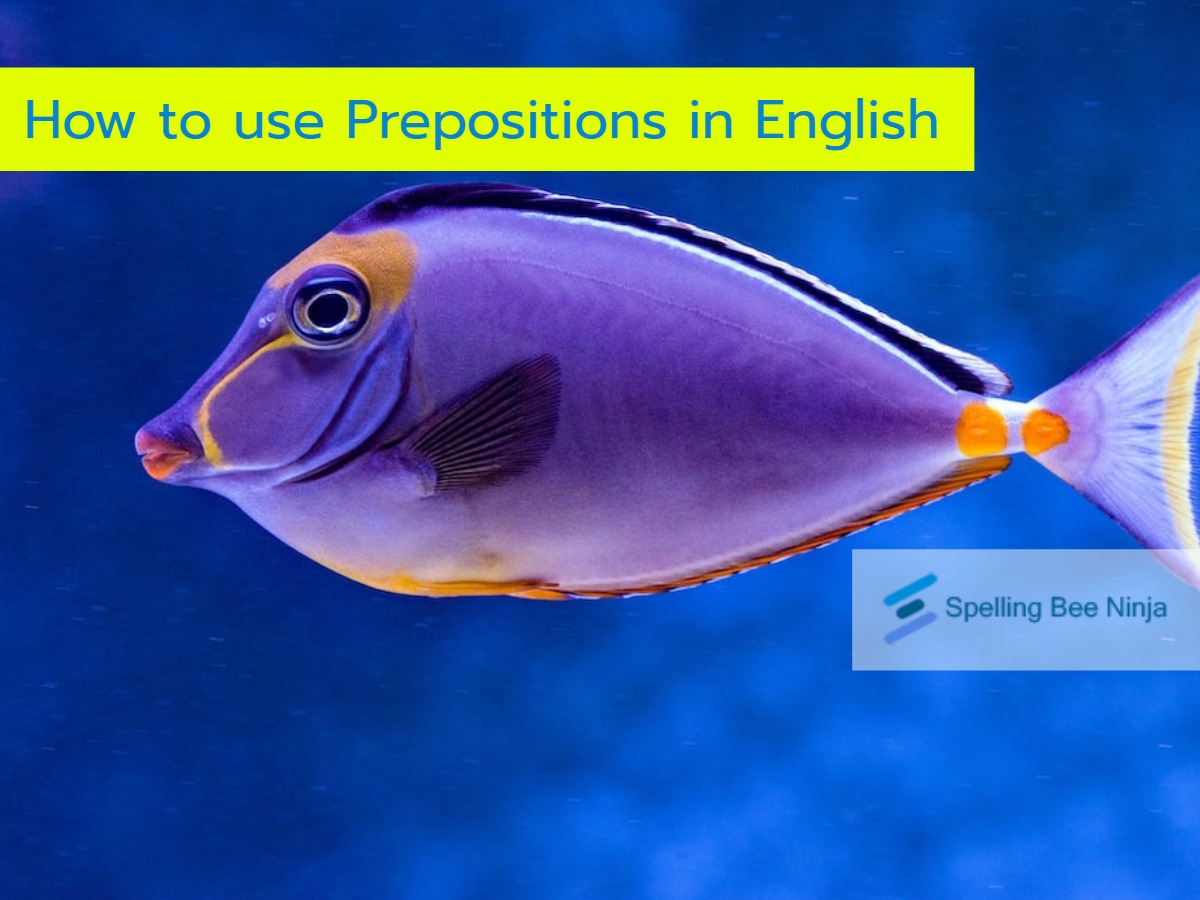For those who are learning English, ‘prepositions’ might have similar concept of certain word class in your native language. On the other hand, for English native speakers might not realize the concept of prepositions consciously. Since they get used to follow the pattern of sentences they often hear to use the proper prepositions. Whether you are a native or non-native speaker of English, follow this thorough explanation on how to use prepositions including the examples.
What do ‘prepositions’ mean?
The term ‘prepositions’ refer to a group of words that indicates a relationship involving location, time, direction, logical argument, or other connections between words in a clause or a sentence. Most of them are followed by a pronoun or noun phrase. Just like its name ‘pre’ means before and ‘position’ refers to the following word which most likely a pronoun or noun phrase. In contrast if this group of word happens after the pronoun or noun phrase, it is called as postpositions, not prepositions. Well, this case should be talked about in a different writing.
Types of prepositions
As mentioned before, this group of words is used to indicate the relationship of a certain pronoun or noun phrase in a clause or sentence. Hence based on the relationship, the prepositions can be grouped into these.
- Location: in, at, on, to, from, towards, across, through, between, among
- Time: in, at, on, since, for, until, by, from, to
- Direction: toward, past, down, over, along, inside
- Space: under, in front of, across, behind, next to, ahead of
- Connections: of, with, by,
- Logical argument: about, for, from, in, on, of, by
Check this article to get a complete list of prepositions in English.
As you can see some prepositions belong to several of types of relationships. Indeed, it is possible the meaning of the preposition might be determined by the context of the sentence. Some prepositions are also made of word groups or pairs like apart from, due to, up to, as for, and many more.
How to use prepositions: usage and examples
To help you understand the proper usage of the prepositions, here is presented the highly used prepositions and how to use prepositions in a sentence. Before going into a specific example, remember that a preposition is followed by a pronoun or a noun phrase. The key is that only certain noun phrase is only matched with certain preposition. See the example below.
Prepositions for location
- In
Usage: To indicate something is enclosed or surrounded by something else;
To indicate something occupies space within defined limits.
Example: “There are many trees in the park.”
“She lives in Detroit.”
- At
Usage: To indicate a specific place or point of contact between two surfaces or objects:
Example: “My house is at 234 Oak Street.”
- On
Usage: To indicate something is in contact with a surface or supported by it:
Example: “The books are on the table.”
Prepositions for time
- In
Usage: To indicate something happens during a period of time.
Example: “She completed it in less than an hour.”
“We’re planning to visit in November.”
- At
Usage: To indicate when something happens;
To indicate time During a period.
Example: “The program starts at 9:00 pm.”
“Her plane should arrive at noon.”
“She works at night.”
“I study at weekends.”
- On
Usage: To indicate Days and Dates.
Example: “We’re traveling on Friday”
“My birthday is on October 1st”
Prepositions for direction
- Toward
Usage: To indicate movement or orientation in the direction of something, with a sense of getting closer to it.
Example: “We started walking toward the mountain peak in the distance.”
- Past
Usage: To indicate movement beyond a certain object, point, or obstacle, without implying anything specific on the opposite side.
Example: “Walk past the big oak tree, then turn left at the field.”
“The ship sailed past the rocky cliffs out into open sea.”
- Down
Usage: To indicate direction or movement from a higher to a lower level or position
Example: “The climber rappelled down the steep cliff face.”
“We were lost until we walked down the mountain to the nearest town.”
Prepositions for space
- Under
Usage: To indicate direction or position below or beneath something above
Example: “The cat curled up under the chair.”
- In front of
Usage: To indicate direction or position in the space leading ahead of or preceding something else.
Example: “A tree had fallen in front of the driveway, blocking the exit.”
- Down
Usage: To indicate direction or movement from a higher to a lower level or position
Example: “The climber rappelled down the steep cliff face.”
Prepositions for connections
- Of
Usage: To indicate relationships of belonging, connection, or association.
Example: “The sleeves of his coat were torn.”
“The lid of the box was loose.”
- With
Usage: To indicate connection, association, or linkage between two or more things.
Example: “She went to lunch with a friend.”
“The safecracker opened the safe with his tools.”
- By
Usage: To indicate different types of connections.
Example: “The sculpture was made by an artist from Greece.” (agency or instrumentality)
“My grandfather traveled here by ship from Europe.” (means of transport)
“The workload increased by 30% this quarter. (measurement or rate)
Prepositions for logical argument
- About
Usage: To introduce or convey the topic, subject matter, or logical argument that follows.
Example: “Have you read anything about the new public transit plans?” (topic/subject matter)
“The author’s central argument about economic policy is not convincing.” (logical claim/position)
“There has been confusion about the terminology used in the reports.” (scope/frame of reference)
- For
Usage: To indicate the function or intended purpose of an object or action.
Example: “Several reasons were given for the new policy.” (in support of)
“I can’t concentrate for all the background noise.” (because of)
“I’ll trade you this sandwich for your cookies.” (in exchange for)
“This spray is specially formulated for killing weeds.” (intended purpose)
- From
Usage: To indicate logical argument applications in terms of indicating source, difference, or opposition.
Example: “This tradition comes from ancient rituals celebrating the solstice.” (source/origin)
“Their methodology differs from standard practices in several ways.” (contrast/distinction)
“We faced resistance from factions preferring the status quo.” (opposition)
Those are just examples of how to use prepositions along with their examples in a sentence. It’s a bit tricky learning the prepositions since it has various meanings and compatible with certain noun phrase/pronoun only. The tips is to read more high-quality English writing, so you can get used to see the proper prepositions in a sentence!
- ✈️ How to Use Articles in English
- 🐝 Mastering Adjectives: A Key to Enhancing Your Writing Skills
- 🎮 Pronoun Puzzle: A Fun Way to Practice Personal and Possessive Forms
- 🎮 Adjective Adventure: Descriptive Word Search!
- ✈️ How to use prepositions in English
- ✈️ English Adverbs – 5 Quick and Easy ways to learn.
- The definitive pronouns list
- 🐝 Understanding conjunction words and where to use them
- ✈️ Modal Verbs in English: A Comprehensive Guide
- 🐝 Prepositions list – The definitive guide
- ✈️ Active and Passive Voice
- ✈️ What vs Which: differences and examples
- 🐝 Complete transition words list
- ✈️ How to Use Punctuation in English
- ✈️ Exploring the Difference Between “Will” and “Shall” in English
- ✈️ The Difference Between Could, Should, and Ought in English
- ✈️ Common Idiomatic Expressions in English
- ✈️ 40 English Prefixes and their meanings
- ✈️ 30 Most common English suffixes and their meaning.
- 🐝 Linking Words In English And How To Learn Them Effectively
- ✈️ Comparative and Superlative Adjectives
- ✈️ The Six Noun Types (Common, Proper, Countable, Uncountable, Collective, Abstract)
- ✈️ Understanding English Clauses: A Complete Guide
- ✈️ Understanding Sentence Structure in English
- ✈️ Gerunds and Infinitives: Understanding Verb Complements in English
- ✈️ Common Pronunciation Mistakes and How to Fix Them
- ✈️ Question Formation in English
- ✈️ Common Sentence Errors: Fragments, Run-ons, and Misplaced Modifiers
- ✈️ Say What?! A Fun Guide to Direct and Indirect Speech
- ✈️ Commonly Confused Words
- 🐝 ELA vocabulary: Essential English Language Arts Terms Every Student Should Know
- ✈️ Formal vs. Informal Language
- ✈️ Mastering Phrases in English Grammar
- ✈️ Conditionals (Zero, First, Second, Third, Mixed Conditionals)
- ✈️ Emphasis and Inversion in Sentences
- ✈️ Understanding and Using the Imperative Form


